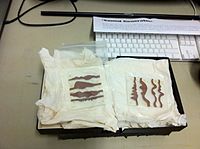- Oramics
-
Oramics is a drawn sound technique designed in 1957 by musician Daphne Oram. The machine was further developed in 1962 after receiving a grant from the Gulbenkian Foundation. The technique, similar to Yevgeny Sholpo's "Variophone", involves drawing on 35mm film strips to control the sound produced.
Oram's composition machine consisted of a large rectangular metal frame, providing a table-like surface traversed by ten synchronised strips of clear, sprocketed 35mm film. The musician drew shapes on the film to create a mask, which modulated the light received by photocells. Although the output from the machine was monophonic, the sounds could be added to multitrack tapes to provide more texture.
The original machine is on display at the Science Museum in London from 29 July 2011 to 1 December 2012.[1][2]
The technique has similarities to that used by Scottish filmmaker Norman McLaren, some of whose films featured sounds created by drawing or printing various patterns, such as triangles and circles, along the optical soundtrack area of the film.
Oramics was also the name used by Oram to refer to her studio and business interests generally.
See also
- ANS synthesizer
- Variophone
- RCA Synthesizer
References
- ^ "Daphne Oram's Oramics Machine to go on display", BBC News 2011-04-04, accessed 2011-05-29
- ^ http://www.sciencemuseum.org.uk/visitmuseum/galleries/oramics.aspx
External links
- Daphne Oram: a tribute to a pioneer
- Daphne Oram and "Oramics"
- Nick Street's video "Oramics" (2011), showing in detail the machine's internals
- Giles Wilson (23 January 2003). "Daphne Oram, the unsung pioneer of techno". BBC News online. http://news.bbc.co.uk/1/hi/uk/2669735.stm.
- "How Daphne Oram's Oramic machine changed electro music". BBC News Technology. 4 April 2011. http://www.bbc.co.uk/news/technology-12956702.
Categories:
Wikimedia Foundation. 2010.


